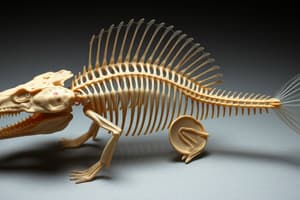Podcast
Questions and Answers
What characteristic distinguishes most chordates from other animals?
What characteristic distinguishes most chordates from other animals?
- Presence of a backbone (correct)
- Lack of a nervous system
- Absence of limbs
- Exclusively aquatic lifestyle
What key evolutionary trait allows reptiles to reproduce away from water?
What key evolutionary trait allows reptiles to reproduce away from water?
- Lungs for breathing
- Limbs for support
- Decreased body temperature
- Amniotic egg (correct)
Which trait is unique to amphibians compared to other vertebrate groups?
Which trait is unique to amphibians compared to other vertebrate groups?
- Reproductive strategies involving external fertilization
- Smooth skin without scales (correct)
- Presence of lungs in adults only
- Ability to live exclusively in aquatic environments
Which group of fish is considered the most evolutionarily advanced?
Which group of fish is considered the most evolutionarily advanced?
What anatomical feature is primarily responsible for the amphibians' dependence on water?
What anatomical feature is primarily responsible for the amphibians' dependence on water?
Which characteristic is true of all mammals?
Which characteristic is true of all mammals?
What is a common misconception regarding amphibians compared to reptiles?
What is a common misconception regarding amphibians compared to reptiles?
What trait does not characterize terrestrial tetrapods?
What trait does not characterize terrestrial tetrapods?
Which group of animals is exclusively characterized by raising their young in pouches?
Which group of animals is exclusively characterized by raising their young in pouches?
What is the primary distinction between Eutherians and Monotremes?
What is the primary distinction between Eutherians and Monotremes?
Which of the following statements best describes the evolutionary relationship between humans and chimpanzees?
Which of the following statements best describes the evolutionary relationship between humans and chimpanzees?
How recently did the human lineage diverge from other primate groups based on fossil evidence?
How recently did the human lineage diverge from other primate groups based on fossil evidence?
Which of the following is the oldest known primate group?
Which of the following is the oldest known primate group?
Where did the earliest members of Homo sapiens first appear?
Where did the earliest members of Homo sapiens first appear?
Which characteristic is considered a key feature of primates?
Which characteristic is considered a key feature of primates?
Which group is NOT classified as a type of mammal?
Which group is NOT classified as a type of mammal?
Flashcards
Chordate Classification
Chordate Classification
Most chordates are vertebrates, meaning they have a backbone.
Human Phylum
Human Phylum
Humans belong to the chordate phylum.
First Chordate Trait
First Chordate Trait
The skull and backbone evolved before other features like amniotic eggs.
Hagfish Relatives
Hagfish Relatives
Signup and view all the flashcards
Amphibian Water Dependence
Amphibian Water Dependence
Signup and view all the flashcards
Most Recent Fish Evolution
Most Recent Fish Evolution
Signup and view all the flashcards
Terrestrial Tetrapod Trait
Terrestrial Tetrapod Trait
Signup and view all the flashcards
Amphibian Traits
Amphibian Traits
Signup and view all the flashcards
Mammal on land?
Mammal on land?
Signup and view all the flashcards
Mammal Subgroups
Mammal Subgroups
Signup and view all the flashcards
Pouched Mammals
Pouched Mammals
Signup and view all the flashcards
Human Subgroup
Human Subgroup
Signup and view all the flashcards
Primate Groups
Primate Groups
Signup and view all the flashcards
Human's Closest Relative
Human's Closest Relative
Signup and view all the flashcards
Oldest Primate Group
Oldest Primate Group
Signup and view all the flashcards
Human Evolution
Human Evolution
Signup and view all the flashcards
Study Notes
Chordates and Vertebrates
- Most chordates are vertebrates.
- Humans belong to the phylum Chordata.
- The skull and backbone evolved first in chordates.
- Lampreys are most closely related to hagfishes.
- Amphibians are tied to water for reproduction due to their eggs lacking an amnion.
- Bony fishes evolved most recently among the fish groups.
- Terrestrial tetrapods live on land and have four limbs.
- Amphibians have gills as juveniles and lungs as adults, respiring through their skin, and have smooth skin without scales, feathers, or hair.
- Reptiles have amniotic eggs that can survive on dry land, differentiating them from amphibians.
- Fish have gills and a lateral line system, while amphibians have strong musculoskeletal systems for terrestrial support.
Fish, Amphibians, Reptiles, and Mammals
- Birds are reptiles.
- All mammals have mammary glands and hair, giving birth to live young (exceptions exist).
- Mammals are most closely related to reptiles.
- Not all mammals live on land.
- Mammals are categorized into Eutherians, Monotremes, and Marsupials.
- Marsupials raise their young in pouches.
- Humans are Eutherians.
Primates and Human Evolution
- Lemurs, apes, and monkeys are primates.
- Chimpanzees are humans' closest living relatives.
- Lemurs are the oldest known primate group.
- Humans share a common ancestor with chimpanzees.
- The hominin lineage split from other primates about 6 million years ago.
- The oldest fossil of Homo sapiens is about 300,000 years old.
- Primates have large brains in relation to their body size.
- The earliest Homo sapiens fossils were found in Africa.
Studying That Suits You
Use AI to generate personalized quizzes and flashcards to suit your learning preferences.




